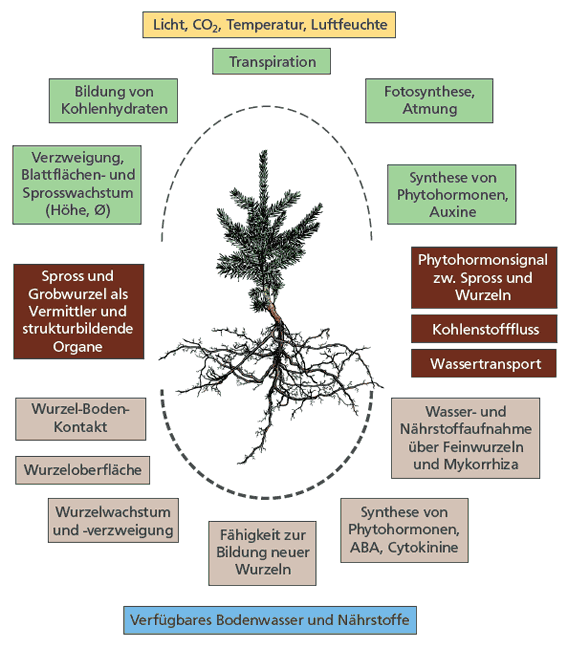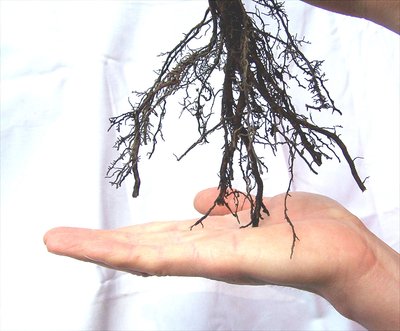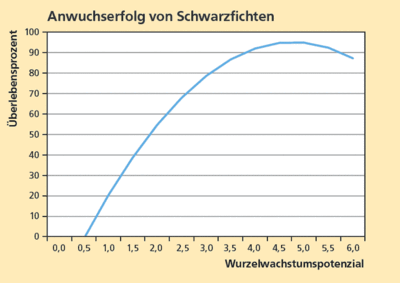The artificial establishment of stands is gaining in importance again in times of forest conversion and the rehabilitation of degraded land areas. The taking root, survival and continued growth of the forest plants depend on the choice of the plants, their outer and inner characteristics, and their ability to form new roots. The formation of new roots minimises the shock of planting often caused by water stress.

Fig. 1: The optimum forest plant - a balanced, reciprocal, functional relationship between shoot and root is an important prerequisite for a high level of morphological and physiological plasticity, successful establishment and good growth. The diagram gives an overview of the key factors and processes (Source: U. Wasern, WSL).
Distribution of tasks in the roots
The physiological tasks of the roots are the uptake, transport and storage of water and nutrients, as well as the synthesis, provision and transport of plant hormones and secondary plant substances. Roots can take many forms and form so-called root systems from different types of roots. Fine and very fine roots are primarily responsible for the uptake of water and nutrients, supported by symbionts such as mycorrhizae or bacteria. Roots like these are relatively short-lived (from a few months to a maximum of two years) but they are replaced by the plant in an ongoing process. They are usually not capable of secondary thickening. The structural root system is made up of different thicknesses of roots and it is what supports the tree.
The primary root
The tree’s genetics determine its root type, the shape of its primary root (radicle), the branching of its roots and how its roots are distributed in the soil. The primary roots of different tree species differ in terms of the depth to which they grow. Drought-adapted tree species such as oak or chestnut have a deep-reaching, pronounced and usually thickened primary root. Tree species with a primary root like this can easily escape the competition from other tree species and use deeper soil layers for themselves. In the youth phase, the deep-reaching primary root also performs the important function of anchoring the tree to the ground. The primary roots of many tree species exhibit positive geotropism at the seedling stage; they grow with gravity, i.e. vertically downwards, while the lateral roots grow horizontally.
If the primary root is injured - because of undercutting or unfavourable environmental conditions (e.g. the pruning of aerial roots) - several adventitious roots often develop above the cut surface. These may also show positive geotropism in their growth. They thus take over the function of the primary root. However, this regeneration sometimes fails to materialise, making young trees more susceptible to windthrow.
If the tree loses the tip of its primary root, it also loses its perception of gravity. From this time on, the root no longer knows which way is up and which way down. This sensor first has to be re-developed. This process binds some of the tree’s resources, which cannot then be put into overground growth.
Relationship of root to shoot
In the forestry industry, the root-shoot ratio is often understood as the relationship between root depth and shoot height; in fact, the data given in literature usually refers to biomass or volume ratios. Many studies show that seedlings with larger root masses or root volumes when they are planted out - particularly in dry conditions - take root and survive better than those with less root mass. “Top-heavy” seedlings have problems in dry environmental conditions, because the insufficiently developed root system cannot cover the young plant’s water requirements.
Seedlings with well developed fine and very fine root systems thrive better. They have a relatively large root surface area with lots of root tips. The main lateral roots are important as starting points for ramification. Conifers in particular use these to take over the upper layers of the forest soil.
Root pruning and its consequences
Root pruning leads to the sudden reduction of the water and nutrient uptake of the tree and to disruption of the plant hormone balance. The latter is crucial for the synchronised development of the shoot and root (Fig. 1). The shoot’s elongation growth is reduced immediately; there is only slight influence on the growth of the undamaged root parts. The water potential in the shoot falls quickly and the plant is subjected to drought stress. The transpiration of the leaves clearly exceeds the water uptake from the soil; the stomata become smaller, thus limiting the uptake of carbon dioxide and restricting photosynthesis.
The plants act so as to establish a dynamic balance between internal carbon flow and the flow of nutrients and water. This balance is achieved by the coordinated growth of shoot and root. Phytohormones act as signal substances in the interaction of root and shoot (Fig. 1) and mediate between root and shoot until this equilibrium is reached. Root pruning disturbs the interaction between root and shoot interaction for several days or weeks: If a large proportion of the root tips are removed, the production of phytohormones of the cytokinine group is drastically reduced. The shoot is thus temporarily prevented from using any assimilates for its own growth. Instead the shoot produces auxins and transfers these to the roots. The auxins induce increased elongation growth of the roots and the intensive formation of new lateral roots.
Two types of root-pruning
Undercutting in the nursery leads to a smaller, more compact fine root system that can be planted without causing serious injury to the roots and that counteracts damage caused by dryness. If pruned correctly, the root can regenerate within a short time of being cut. Long-term losses in growth are not to be expected.
Root-pruning before planting is often considered not to make sense. As well as some unavoidable effects of raising the plants from the seed bed or nursery (sometimes high loss of fine root mass), there are also losses to root mass caused during transport or planting. The ratio between water-supplying surface and water-transpiring surface is changed dramatically. In order to survive, the plant must re-develop its root system to its former size.
Root-pruning: with caution
Root-pruning was once a routine measure to reduce the size of the root system and to shape it so that it could be introduced into the planting hole quickly and easily. Nowadays root-pruning is no longer a routine measure, but only carried out to remove injuries and reduce deformation of the roots. Root-pruning should thus not affect more than 20 percent of the mass of fine and finest roots. Cut surfaces with a diameter of more than four millimetres must be avoided. Root-pruning generally before planting should be viewed critically, as the cut may lead to the maiming of a vital organ, the functionality of which may be impaired or even lost completely.
Conclusions for forestry practice and research
Planting technique: It is essential to use the right planting technique for a planting measure to succeed. It should be selected in such a way that the root can be planted in the soil with as little damage as possible. The basic principle is: “The planting technique must be adapted to the plant”. Generally, planting techniques should be preferred that create a generous plant hole volume, so that the natural three-dimensionality of the root system is maintained.
Root volume and root-shoot ratio: For the plants to take root successfully, root growth should start immediately after planting. Fresh plants with larger root volumes are better able to take in water, withstand the shock of planting better, and have better chances of surviving. In the optimum forest plant there should be a harmonious, balanced, functional ratio between shoot and root.
Water supply: The shock of planting is slight if the plants have enough soil contact and water and atmospheric evaporation is low. In dry-warm weather conditions at planting, a serious shortage of water may arise. This can be countered by choosing the best planting time, for example (autumn planting), or by watering artificially.
Research requirements: Further research is needed at the forest research institutes. It should be possible to deduce the effect of the different planting techniques and previous procedural steps on the tree species and plant assortments, and for the most important sites.


